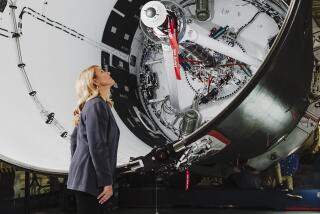‘Chief skunk’ at a hush-hush weapons complex
- Share via
The gig: Alton D. Romig Jr., 58, is “chief skunk” at Lockheed Martin Corp.’s famed Skunk Works secretive weapons development facility in Palmdale. It’s one of the most coveted jobs in aerospace.
For more than 70 years, workers at the shadowy site have designed and built the world’s most innovative military aircraft, including the U-2 spy plane, SR-71 Blackbird and F-117 stealth fighter. About 2,000 people work on 600 programs at Skunk Works, which got its nickname in 1943 at its original Burbank headquarters that was located next to a manufacturing plant that produced a strong odor.
Secrecy: About 90% of all the work is classified. Romig wouldn’t specify what goes on there or how much money is involved. “I think it’s safe to say it’s in the hundreds of millions of dollars” was all he would say. The Skunk Works mantra is “quick, quiet and quality,” he said, and it guides every project from concept to flight. Romig works in a windowless office to ensure security, and most projects in the facility are so secret that employees can’t tell one another what they’re working on.
Takeoff: Being named vice president and general manager of advanced development programs for Lockheed in January 2011 was a culmination of a life’s dream for Romig.
As a child from Telford, Pa., a rural town in the eastern part of the state, Romig and his father would make the 35-mile drive to what is now Lehigh Valley International Airport in Allentown to watch the latest commercial aircraft take off and land. They would stand atop the highest concourse for a glimpse of the action. “I was always in awe of what a jet could do compared to what props could do,” he said. “The power was simply amazing.”
American idols: While other boys his age were enamored with sports stars like Mickey Mantle or rock ‘n’ roll icons like Elvis Presley, Romig had other heroes. Three men shaped his life, he said. The first was Wernher von Braun, the engineer who led NASA’s development of the Saturn V rocket that put man on the moon. The second was J. Robert Oppenheimer, the physicist known as the “father of the atomic bomb” for leading the Manhattan Project during World War II. The third was Clarence “Kelly” Johnson, the engineer who founded the Skunk Works and headed the project to build the nation’s first fighter jet, the XP-80 Shooting Star.
“While each of these men were proficient in their chosen professions, none of them were really known for the work that they personally accomplished,” Romig said. “They were known for leading teams of brilliant engineers and scientists. I guess I have that same gene inside me.”
Nukes: After graduating from Lehigh University with a doctorate in materials science, Romig got a job with Sandia National Laboratories in Albuquerque, now operated by Lockheed. In his more than 30 years with Sandia, he held a variety of management assignments, including chief scientific officer for the nuclear weapons program.
Pillow talk?: At Sandia, Romig met his wife, Julie, a now-retired chemical engineer. Although most Americans may go home to their spouse and unload after a bad day at work, there’s little about his job that Romig can discuss with his wife. He’s had a government-vetted security clearance since 1979. “She’s never asked, and I’ve never told,” he said. “I’ve been in the black world for so long.”
They live on Christmas Tree Lane in Lancaster, so in December they deck out the outside of their home with lights, ornaments and fake reindeer. The intense engineer he is, Romig can tell you exactly how much electricity it takes to light up. “Sixty-eight amps,” he said.
The couple will celebrate 30 years of marriage in September. They have one married son and a granddaughter.
His goal in sight: For the better part of a year while he was at Sandia, Romig interviewed for the Skunk Works job. On the Tuesday before Thanksgiving 2010, Romig received a call telling him he had landed it. All he could think about was childhood hero Kelly Johnson: “I knew I would be stepping into the role of an icon.”
When he’s not in Palmdale, Romig spends much of his time at Lockheed aircraft manufacturing plants in Marietta, Ga., and Fort Worth, where about 35% of Skunk Works employees, called “skunks,” work.
Spare time: Romig said he and his wife share a love of the arts and history. They are members of the Page Museum at the La Brea Tar Pits and the Natural History Museum of Los Angeles County.
Leading leaders: As the head of one of the most innovative engineering teams in the world, Romig offered these leadership tips. “Don’t be afraid to trust your employees to do their jobs,” he said. “Don’t be afraid of failure. Learn from it.”
More to Read
Inside the business of entertainment
The Wide Shot brings you news, analysis and insights on everything from streaming wars to production — and what it all means for the future.
You may occasionally receive promotional content from the Los Angeles Times.











